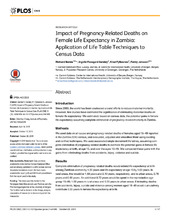| dc.description.abstract | Introduction: Since 2000, the world has been coalesced around efforts to reduce maternal mortality. However, few studies have estimated the significance of eliminating maternal deaths on female life expectancy. We estimated, based on census data, the potential gains in female life expectancy assuming complete elimination of pregnancy-related mortality in Zambia. Methods: We used data on all-cause and pregnancy-related deaths of females aged 15–49 reported in the Zambia 2010 census, and evaluated, adjusted and smoothed them using existing and verified techniques. We used associated single decrement life tables, assuming complete elimination of pregnancy-related deaths to estimate the potential gains in female life expectancy at birth, at age 15, and over the ages 15–49. We compared these gains with the gains from eliminating deaths from accidents, injury, violence and suicide. Results: Complete elimination of pregnancy-related deaths would extend life expectancy at birth among Zambian women by 1.35 years and life expectancy at age 15 by 1.65 years. In rural areas, this would be 1.69 years and 2.19 years, respectively, and in urban areas, 0.78 years and 0.85 years. An additional 0.72 years would be spent in the reproductive age group 15–49; 1.00 years in rural areas and 0.35 years in urban areas. Eliminating deaths from accidents, injury, suicide and violence among women aged 15–49 would cumulatively contribute 0.55 years to female life expectancy at birth. Conclusion: Eliminating pregnancy-related mortality would extend female life expectancy in Zambia substantially, with more gains among adolescents and females in rural areas. The application of life table techniques to census data proved very valuable, although rigorous evaluation and adjustment of reported deaths and age was necessary to attain plausible estimates. The collection of detailed high quality cause-specific mortality data in future censuses is indispensable. | en_US |

